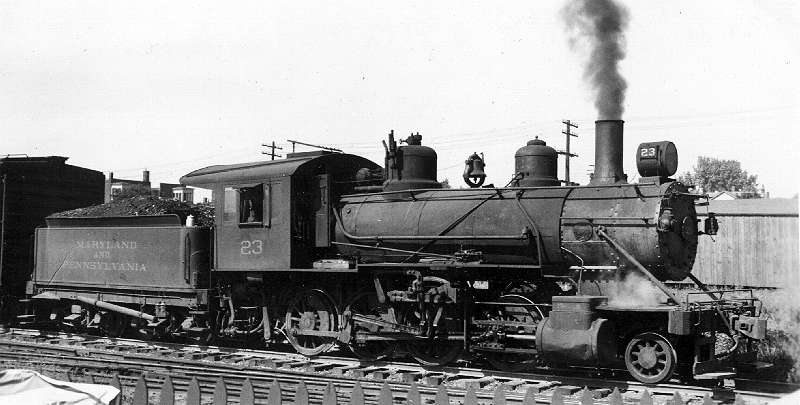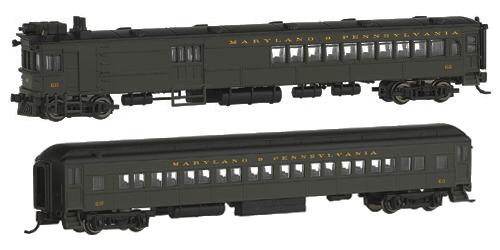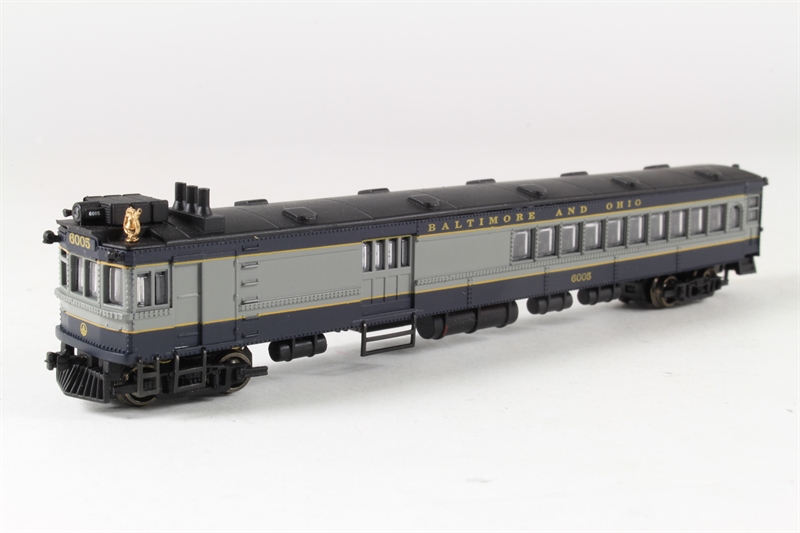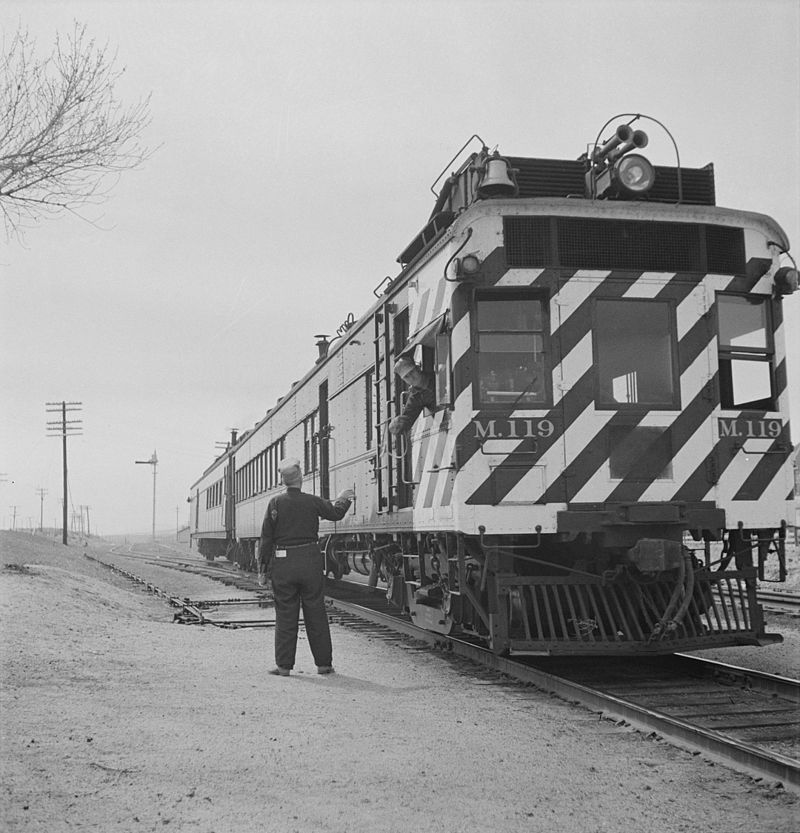Series Information: Spectrum is a line of higher quality models introduced by Bachmann in the 1990's.
Model Information: Originally released in 1998 as a single car DC model with a Rapido coupler, the DCC decoder versions that were released in 2011 are fitted with E-Z-Mate Mark II operating knuckle couplers and are accompanied by a 72 foot heavyweight trailer coach car.
Prototype History: In 1923 the Electro-Motive Company began production of self-propelled railcars, subcontracting bodies to the St. Louis Car Company, prime movers to the Winton Engine Company, and electrical equipment to General Electric.
Commonly called Doodlebugs, self-propelled passenger cars (gas-electrics) with gasoline engines that spun generators, which in turn provided electricity to the traction motors that turned the wheels were popular with American railroads in the early part of the 20th century. Thrifty to operate on lightly traveled local and regional lines, with their forward baggage sections, Doodlebugs provided economical mail and passenger service. Although they were more often used singly, Doodlebugs sometimes pulled trailer cars when additional capacity was needed.
Commonly called Doodlebugs, self-propelled passenger cars (gas-electrics) with gasoline engines that spun generators, which in turn provided electricity to the traction motors that turned the wheels were popular with American railroads in the early part of the 20th century. Thrifty to operate on lightly traveled local and regional lines, with their forward baggage sections, Doodlebugs provided economical mail and passenger service. Although they were more often used singly, Doodlebugs sometimes pulled trailer cars when additional capacity was needed.
Road Name History:  The Ma & Pa (as it was known) was the result of the 1901 merger of two lines together linking Baltimore, Maryland with York, Pennsylvania. Although these cities are just 45 miles apart, it took the Ma & Pa 77 miles of route to connect them. The predecessors had been originally constructed to 3’ gauge so tight curves, light bridges, and thin roadbed were the rule. Both were standard gauged before the Ma & Pa merger. At its peak in 1913, they had 573 employees! The largest steam locomotives were 2-8-0’s and they never owned an engine with a trailing truck. With all of the sharp curves (36% of the mileage was curved track) derailments were relatively common. Ma & Pa was one of very few shortlines to have its own derrick.
The Ma & Pa (as it was known) was the result of the 1901 merger of two lines together linking Baltimore, Maryland with York, Pennsylvania. Although these cities are just 45 miles apart, it took the Ma & Pa 77 miles of route to connect them. The predecessors had been originally constructed to 3’ gauge so tight curves, light bridges, and thin roadbed were the rule. Both were standard gauged before the Ma & Pa merger. At its peak in 1913, they had 573 employees! The largest steam locomotives were 2-8-0’s and they never owned an engine with a trailing truck. With all of the sharp curves (36% of the mileage was curved track) derailments were relatively common. Ma & Pa was one of very few shortlines to have its own derrick.
Think of the Ma & Pa as a Virginia & Truckee of the east. The steam locomotives were antiques, the freight cars were wooden, and the coaches had open platforms decades after other lines had modernized.
Traffic included furniture from Red Lion, slate from Delta, and milk from just about every town along the line. Passenger service was exceedingly slow with the daily York to Baltimore train taking 4 hours to cover the 77 track miles. Passenger service ended in 1953.
In 1958, the lines in Maryland were abandoned. The following year, Ma & Pa relaid track on the Peachbottom branch that had been abandoned and pulled up in 1903. A nuclear power plant was under construction at Peachbottom and the Ma & Pa moved construction material on the line for several years. In 1971, Eamons Industries bought the line as a means of entering the freight car leasing business. Over the next decade, the Ma & Pa freight car fleet swelled to over 2,000 cars (and not a wooden one in the lot.)
In 1976, Ma & Pa picked up the former Pennsylvania Railroad line from York to Walkersville, Maryland although that was cut back to Hanover, Pennsylvania just two years later. That year the original Ma & Pa mainline south of Red Lion was abandoned followed by the rest of original mainline in 1983. At that point, the Ma & Pa was operating exclusively on former PRR lines, whose construction standards were much more stout than Ma & Pa’s narrow gauge predecessors.
Late in 1999, Maryland & Pennsylvania merged with another area shortline called Yorkrail. The new railroad is called York Railway with 42 miles of line serving about 40 customers. They are now part of the Genesee & Wyoming shortline family. A short segment of the original Ma & Pa main has been preserved.

Think of the Ma & Pa as a Virginia & Truckee of the east. The steam locomotives were antiques, the freight cars were wooden, and the coaches had open platforms decades after other lines had modernized.
Traffic included furniture from Red Lion, slate from Delta, and milk from just about every town along the line. Passenger service was exceedingly slow with the daily York to Baltimore train taking 4 hours to cover the 77 track miles. Passenger service ended in 1953.
In 1958, the lines in Maryland were abandoned. The following year, Ma & Pa relaid track on the Peachbottom branch that had been abandoned and pulled up in 1903. A nuclear power plant was under construction at Peachbottom and the Ma & Pa moved construction material on the line for several years. In 1971, Eamons Industries bought the line as a means of entering the freight car leasing business. Over the next decade, the Ma & Pa freight car fleet swelled to over 2,000 cars (and not a wooden one in the lot.)
In 1976, Ma & Pa picked up the former Pennsylvania Railroad line from York to Walkersville, Maryland although that was cut back to Hanover, Pennsylvania just two years later. That year the original Ma & Pa mainline south of Red Lion was abandoned followed by the rest of original mainline in 1983. At that point, the Ma & Pa was operating exclusively on former PRR lines, whose construction standards were much more stout than Ma & Pa’s narrow gauge predecessors.
Late in 1999, Maryland & Pennsylvania merged with another area shortline called Yorkrail. The new railroad is called York Railway with 42 miles of line serving about 40 customers. They are now part of the Genesee & Wyoming shortline family. A short segment of the original Ma & Pa main has been preserved.
Brand/Importer Information: Bachmann Industries (Bachmann Brothers, Inc.) is a Bermuda registered Chinese owned company, globally headquartered in Hong Kong; specializing in model railroading.
Founded in Philadelphia, Pennsylvania, the home of its North American headquarters, Bachmann is today part of the Kader group, who model products are made at a Chinese Government joint-venture plant in Dongguan, China. Bachmann's brand is the largest seller, in terms of volume, of model trains in the world. Bachmann primarily specializes in entry level train sets, and premium offerings in many scales. The Spectrum line is the high quality, model railroad product line, offered in N, HO, Large Scale, On30, and Williams O gauge all aimed for the hobbyist market. Bachmann is the producer of the famous railroad village product line known as "Plasticville." The turnover for Bachmann model trains for the year ended 31 December 2006 was approximately $46.87 million, a slight increase of 3.36% as compared to 2005.
Founded in Philadelphia, Pennsylvania, the home of its North American headquarters, Bachmann is today part of the Kader group, who model products are made at a Chinese Government joint-venture plant in Dongguan, China. Bachmann's brand is the largest seller, in terms of volume, of model trains in the world. Bachmann primarily specializes in entry level train sets, and premium offerings in many scales. The Spectrum line is the high quality, model railroad product line, offered in N, HO, Large Scale, On30, and Williams O gauge all aimed for the hobbyist market. Bachmann is the producer of the famous railroad village product line known as "Plasticville." The turnover for Bachmann model trains for the year ended 31 December 2006 was approximately $46.87 million, a slight increase of 3.36% as compared to 2005.
Item created by: nscalemodeler160 on 2016-07-26 07:40:19. Last edited by gdm on 2019-09-21 12:53:44
If you see errors or missing data in this entry, please feel free to log in and edit it. Anyone with a Gmail account can log in instantly.
If you see errors or missing data in this entry, please feel free to log in and edit it. Anyone with a Gmail account can log in instantly.










